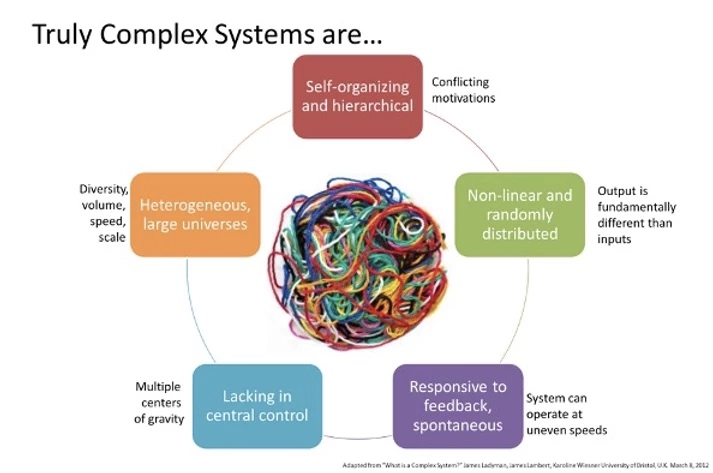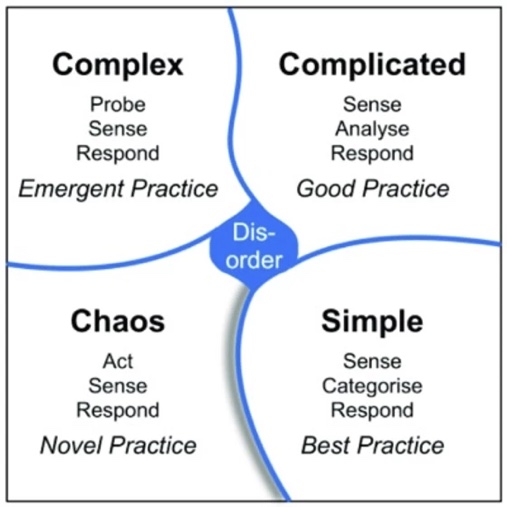
How to Assess Complex Change
This blog is for all of us who deal in change, who navigate the shadow world of today and the promise of tomorrow. This is for those in charge of budgets that must return an ROI on something that is not yet built. We are inventors, doers, list makers, dreamers, operators, deal makers.
Project managers make change in large unruly organizations and in small teams. We operate on the edge of the unknown, trying to build something new across multiple organizations, time zones, cultures, languages and operating assumptions. We navigate deeply ambiguous scenarios, trying not just to create new things, but to win hearts and minds along the way.
“The beginning of wisdom is to call things by their proper name.”
― Confucius
First thing about multifaceted, complex change is that we need to recognize it. Truly complex systems have characteristics that are recognizable.

- Self-organizing and hierarchical. Complex environments have hierarchies of assets and players. Gradations occur naturally – form and reform according to power dynamics at work.
- Non-linear and randomly distributed. This characteristic of complex systems makes problems hard to diagnose.
- Responsive to feedback and spontaneous. Complex systems are living things – they respond to stimuli.
- Lacking in central control. Complex systems have no central authority, and often have multiple centers of gravity. These areas have greater influence over the whole.
- Heterogeneous large universes. Complex systems tend to have many parts and pieces, each operating semi- or fully-autonomously. Think of a flock of sparrows, or a busy city intersection.
Examples of complex systems:
- A new product entering a competitive market.
- A new hospital wing involving demolition, construction, and angry neighbors.
- A network of charities banding together to address a social problem.
- New software being rolled out to a large user base.
We all live in complex systems, but often we don’t recognize them. And when called upon to drive change in a complex environment, project managers can lose their footing because they don’t know where to start.
A Tale About Sales
Operating in a complex environment is less about a controlling mindset, and more about an influencing mindset. Below is another view into complex systems.
I remember my big epiphany about project complexity. My team was hired to implement a new set of processes across a large, global technology organization in Silicon Valley. Our client comprised the Sales Division that sold point of sale hardware, software, and services, with operations in more than thirty countries. Due to rapid, organic growth, their sales processes were a tangled mess that led to internal competition for the same global clients across different geographies. And customers were taking notice, complaining, and demanding better pricing and more coordination – this process needed to be fixed quickly!
The project scope included development of processes for tabulating first-sale and renewal commissions, team-based sales, cross-region sales, exchange rate policies, etc. Additionally, we had key stakeholders from each global region in workshops and online meetings. In conclusion, this was a complex environment!
A Framework for Complex Change

From this wonderful word comes the eponymous Cynefin Framework, a visual approach to understanding organizational context and assumptions. The model was developed by David Snowden in 2002 and published in the Harvard Business Review in 2007.
The model enables organizational sense making – understanding different viewpoints around a construct of Ordered, Complex and Chaotic. The model helps assimilate concepts into domains, and based on that domain, provides approaches to help resolve the challenge. Looking at the graphic, Ordered domains are to the right.
Next, we can consider the modern project environment. So much depends upon context – helping our customers drive behavior changes, system changes, process changes. Let’s explore this model and understand what it means in dynamic, changing environments.
There are five domains in the Cynefin Framework:
Predictable
Simple domains are ordered, repeatable, and the link between a cause and an effect is often immediately obvious. This is the home of best practice. Small, simple projects operate well in this environment – for example a straight forward training project. Root causes of problems are identified. Decision-making can be delegated and there is often a sense of complacency, entrenched thinking and resistance to change.
Complicated domains are considered ordered and predictable, however the relationship between cause and effect is often separated by time and space. This is the realm where expertise rules and individual experience is rewarded. This area calls for fact-based management, and open minds are needed to understand conflicting perspectives. Moderately complicated projects fit in here, for example an IT upgrade.
Unpredictable
Complex domains are fundamentally unpredictable and require innovative thinking and unconventional approaches. In other words, any moderately complex project lives in this domain. Cause and effect are removed enough from each other that the same action may produce completely different results. Complex environments have many competing and emergent ideas that require maturation.
Chaotic environments are defined by high turbulence and tension, no time to consider but only react. Chaos often needs a command style of leadership. The objective of chaotic environments is to get out of them! The trick is to recognize chaos and move the situation to another domain.
The Disordered state is often the state when we cannot identify which of the other states we are in. This is often where we enter a project when it is in failure mode.
The Cynefin framework will work for any project manager serious about eliciting change.
Project Management Pitfalls in Complex Change
- Too much gray area. Not speaking about my beard, either. One of the biggest pitfalls I see is a reluctance to jump into the gray areas, the uncomfortable conversations. We are often great at identifying the issues and logging them, but in a scenario where there are many right answers
- Oversimplification. Project managers are great translators. We convert technical-speak into business language, and legal jargon into real-work tasks. Yet in all of this, there is a tendency to
- Too much focus on critical path. Critical path is a stalwart tool of project management and has a role in many projects. Projects are more complex than ever, and often smaller iterative cycles (e.g., agile) builds a better product. Critical path thinking assumes a linear relationship between cause and effect – if this task is two days late, then the project will be two days late.
In conclusion, to all the project managers and leaders out there struggling to bring about profound change, consider taking a step up in how you view change.
Are you interested in learning more about how Teaming Worldwide can help solve your business’ most pressing issues? Let’s connect. Visit www.teamingworldwide.com/innovation to schedule a discovery call or send us an email at hello@teamingworldwide.com.



